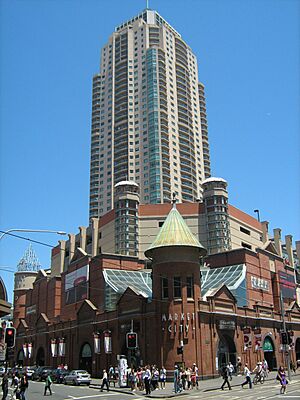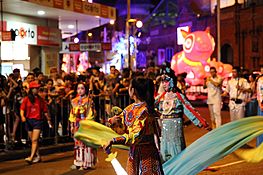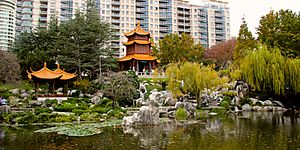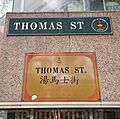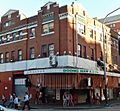Chinatown, Sydney facts for kids
Quick facts for kids ChinatownSydney, New South Wales |
|||||||||||||||
|---|---|---|---|---|---|---|---|---|---|---|---|---|---|---|---|
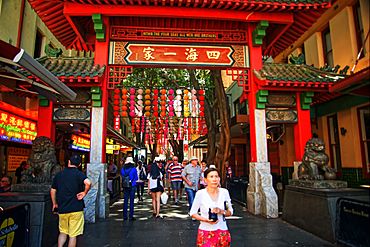
A Chinese paifang at the intersection of Factory Street and Dixon Street
|
|||||||||||||||
| Population | 22,218 (2018) | ||||||||||||||
| • Density | 44,000/km2 (110,000/sq mi) | ||||||||||||||
| Postcode(s) | 2000 | ||||||||||||||
| Area | 0.5 km2 (0.2 sq mi) | ||||||||||||||
| LGA(s) | City of Sydney | ||||||||||||||
| State electorate(s) | Sydney | ||||||||||||||
| Federal Division(s) | Sydney | ||||||||||||||
|
|||||||||||||||
| Sydney Chinatown | |||||||||||||
|---|---|---|---|---|---|---|---|---|---|---|---|---|---|
| Chinese | 悉尼唐人街 | ||||||||||||
|
|||||||||||||
| Alternative Chinese name | |||||||||||||
| Traditional Chinese | 雪梨華埠 | ||||||||||||
| Simplified Chinese | 雪梨华埠 | ||||||||||||
|
|||||||||||||
Chinatown (Chinese: 悉尼唐人街; Cantonese Yale: Sīknèih Tòhngyàhn'gāai; pinyin: Xīní Tángrénjiē) is a special area in the southern part of Sydney central business district (CBD) in New South Wales, Australia. It covers most of the Haymarket suburb, located between Central Station and Darling Harbour. This vibrant area is part of the City of Sydney and is the largest Chinatown in Australia.
Chinese people started moving to New South Wales as early as 1828. The first group of Chinese workers arrived from Xiamen in 1848. When gold was discovered in 1851 during the Australian gold rushes, many more Chinese immigrants came. By 1855, about 17,000 Chinese people had settled in Australia. Most of these early immigrants came from southern China, like Guangdong and Fujian provinces.
Contents
History of Sydney's Chinatown
- Further information: History of Sydney and History of Chinese Australians

Many Chinese people arrived in Australia during the Gold Rush years of the 1850s. After the gold rush ended, large groups decided to stay. They often lived in their own communities and worked in different places across Sydney. Many became market gardeners on the edge of the city.
By 1861, about 13,000 Chinese people lived in New South Wales. At this time, Sydney's Chinatown was in The Rocks area, known as the 'Chinese Quarter'. Over time, negative feelings towards Chinese immigrants lessened. By the 1920s, Sydney's Chinatown moved to Campbell Street, near the popular Capitol Theatre.
Since 2019, Dixon Street and other nearby streets become car-free every Friday from 4 pm. This is to host the popular Friday night markets. You can find many stalls selling Asian street food, desserts, and sweets. These markets are very busy and exciting!
Where is Chinatown Located?
Chinatown's Traditional Heart
Chinatown doesn't have official borders because it keeps growing. The main part of the Haymarket Chinatown has always been around Dixon Street. This is a pedestrian street with many Chinese restaurants. It has a traditional Chinese gateway called a paifang at each end.
Next to Dixon Street, you'll find Sussex Street and George Street. George Street is Sydney city's main road. Other smaller streets and lanes in Chinatown include Factory Street, Goulburn Street, Little Hay Street, Kimber Lane, and Thomas Street.
At the eastern end of Chinatown, near George Street and Hay Street, there's a special sculpture. It's made from a dead tree trunk and was created by artist Lin Li in 1999. It's called Golden Water Mouth. The artist believed it would bring good luck to the Chinese community, following Feng Shui ideas.
How Chinatown Has Grown
The Chinatown we see today is actually the third main area to be called Chinatown in Sydney. When Sydney's produce market moved, the Haymarket and Surry Hills areas became popular for Chinese residents. By the 1920s, Chinatown started to settle in its current spot.
On Hay Street, two big projects helped Chinatown grow even more. The Peak Apartments, a tall residential building, was built in 1996. The Market City shopping complex was also renovated and built over Paddy's Market.
Market City has many food courts with popular restaurants like Haidilao. It also has a huge Dim Sum restaurant called The Eight Modern Chinese Restaurant. You can find unique shops and a large indoor entertainment area called City Amusements. Below it is the Haymarket Paddy's Markets, which is a market for fresh produce and other goods from Wednesday to Sunday.
In late 2017, Darling Square was finished right next to Market City. This added many new apartment buildings and lots of new places to eat. This helped Chinatown become even more connected to the heart of Sydney.
Unlike some other Chinatowns around the world, Sydney's Chinatown is generally safe and clean. However, some people in the Chinese community worry about building height limits. These limits are set by the local government to keep the city looking a certain way.
New Chinatowns in the Suburbs
Over the last twenty years, smaller Chinatowns have appeared in several Sydney suburbs. These include Ashfield, Hurstville, Eastwood, Campsie, Parramatta, Chatswood, Burwood, Flemington and Kingsford.
These suburbs are becoming more diverse. People from specific parts of China often choose to live together in one suburb. For example, Ashfield is sometimes called 'little Shanghai'. Hurstville has many people from Hong Kong. Even with these new areas, Sydney's Chinatown remains a very important social and cultural hub for Chinese Australians in Sydney.
Who Lives in Chinatown?
According to information from 2016, the Chinatown and Haymarket area has many different groups of people. A large part of the population is Chinese (31.9%), Thai (18.3%), Indonesian (5.6%), English (5.1%), and Korean (4.8%).
The most common languages spoken at home, besides English, are Thai (20.4%), Mandarin (20.3%), Indonesian (10.2%), Cantonese (5.1%), and Korean (4.8%). Many students from Asia also live here because it's close to universities like the University of Technology Sydney and the University of Sydney, and TAFE colleges. In 2016, about 25.9% of Chinatown residents were studying at university or TAFE.
Chinatown is in the city center and is becoming part of the growing central business district. Many people who work in offices live here. In 2017, out of 65,950 workers in the area, 18% worked in finance, 17% in government, and 13.6% in professional services. The average weekly household income in 2016 was $1,696, which was a bit higher than the national average.
The Chinese Garden of Friendship
Sydney is a sister city to Guangzhou in China. As a gift to Sydney for the Australian Bicentenary in 1988, the Chinese Garden of Friendship (traditional Chinese: 誼園; simplified Chinese: 谊园; pinyin: yìyuán; Cantonese Yale: yihyùhn) was built. It's located west of Chinatown in the Darling Harbour area.
Sydney and Guangzhou have a strong connection because of trade and people moving between the two places for a long time. Guangzhou designed the garden and provided important building materials, furniture, and artworks. New South Wales managed and paid for its construction.
This garden is one of the few traditional Chinese gardens outside of China that is open to the public. It's designed like a private scholar's garden. The gardens were added to the New South Wales State Heritage Register in 2018, which means they are very important to protect. The garden offers many activities, like lessons about its history, guided tours, school visits, and even koi fish feeding.
Street Signs in Two Languages
You'll see many street signs in Chinatown that are written in both English and Chinese. Some of the Chinese names are based on how they sound in Cantonese, like Hay Street (禧街). Others are based on how they sound in Mandarin, like Liverpool Street (利物浦街).
Some of these special signs are placed next to the official City of Sydney street signs. At the bottom of each sign, it says "Welcome to Chinatown" and "歡迎光臨華埠" in Chinese.
Chinatown in Movies and Music
Sydney's Chinatown has been featured in several popular films and music videos:
- The music video for David Bowie's 1983 song China Girl was filmed here.
- Parts of the 1999 Australian film Two Hands take place in Sydney Chinatown.
- A scene for Dulcea's area in the 1995 superhero movie Mighty Morphin Power Rangers: The Movie was filmed here.
- It also appeared in the movie The Wolverine in October 2012.
Images for kids
-
The Sydney office of the Kuomintang


